
Elisabeth Eberhardt (born 5th February 1875 in Lenzburg, died 2nd October 1966 in Lenzburg), undated photograph. © Museum Burghalde Lenzburg. www.museumburghalde.ch.
Pottery by Elisabeth Eberhardt in CERAMICA CH
As well as Nora Gross (1871-1929), Elisabeth Eberhardt (born 5th February 1875 in Lenzburg, died 2nd October 1966 in Lenzburg) was one of the first women in Switzerland to train as a ceramicist. She should, in fact, be identified as a ceramic designer and pottery painter, as she never learned how to throw pottery and therefore had to rely on professional potters to assist her in that respect. Her pottery shapes were made to her designs or based on her direct instructions. The decorations and later the glazes were her own creations.
All of what we know about Elisabeth Eberhardt was researched and published by Barbara von Orelli-Messerli (1987 and 2010, including a catalogue of all of Eberhardt’s designs known before 1987).
Margaritha Elisabeth Eberhardt was born on 5th February 1875. She was the youngest of three children of Fritz Eberhardt, a businessman from Lenzburg and his wife Helene Landolt. We know very little about Elisabeth’s early years, nor why she decided, in 1903 at the age of 28, to “follow my great desire” and go to Steffisburg to work in a pottery workshop.
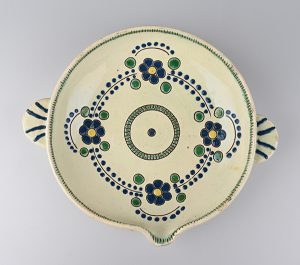
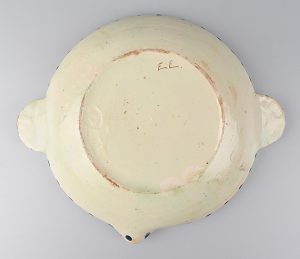

Porringer, signed “E.E.”, private ownership, Switzerland.
Thanks to a signed jug, we can assume that she was employed at the workshop of Karl Loder-Eyer (1871-1915), where she decorated pottery and was permitted to sign her works with her own initials, “E.E”.
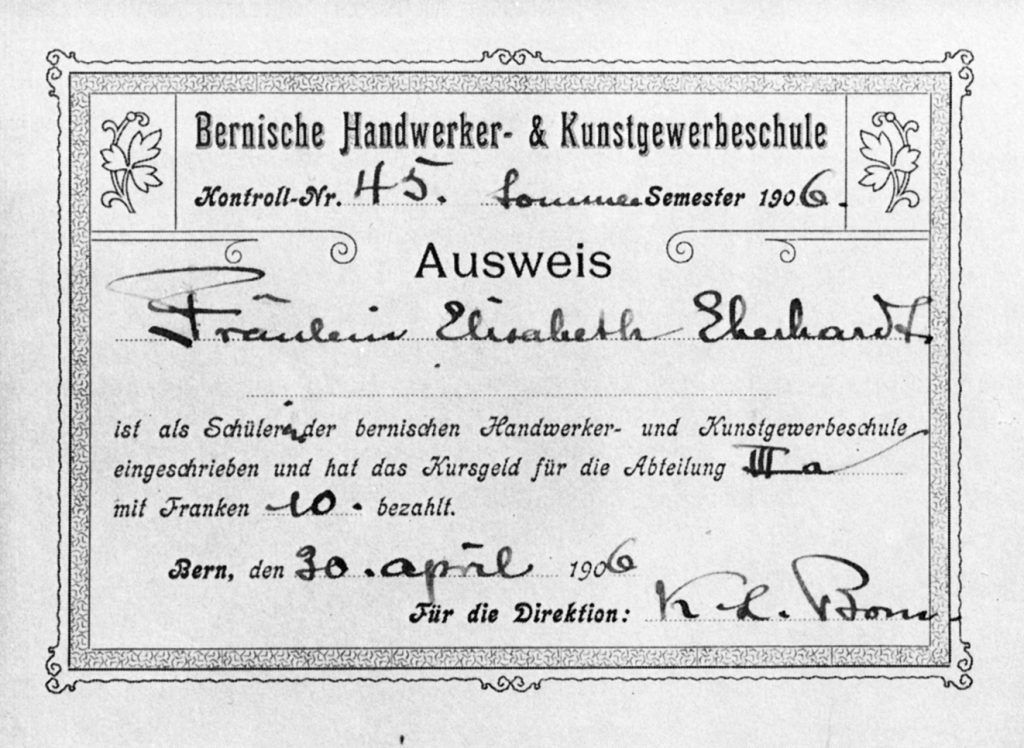
Student ID from the School of Arts and Crafts in Bern, summer semester 1906. Photo © Museum Burghalde Lenzburg. www.museumburghalde.ch.
When she began to work in Steffisburg she also entered the School of Arts and Crafts in Bern, which she attended from 1903 to 1906. It is not known whether she enrolled in the pottery class, which started in 1905, or whether she “only” attended the general arts and crafts courses. She probably attended drawing classes with Paul Wyss, who taught at the school from 1900 to 1918 and was a hugely influential figure in pottery design, making an impact on the objects created by ceramicists in Langnau, Heimberg and Steffisburg.
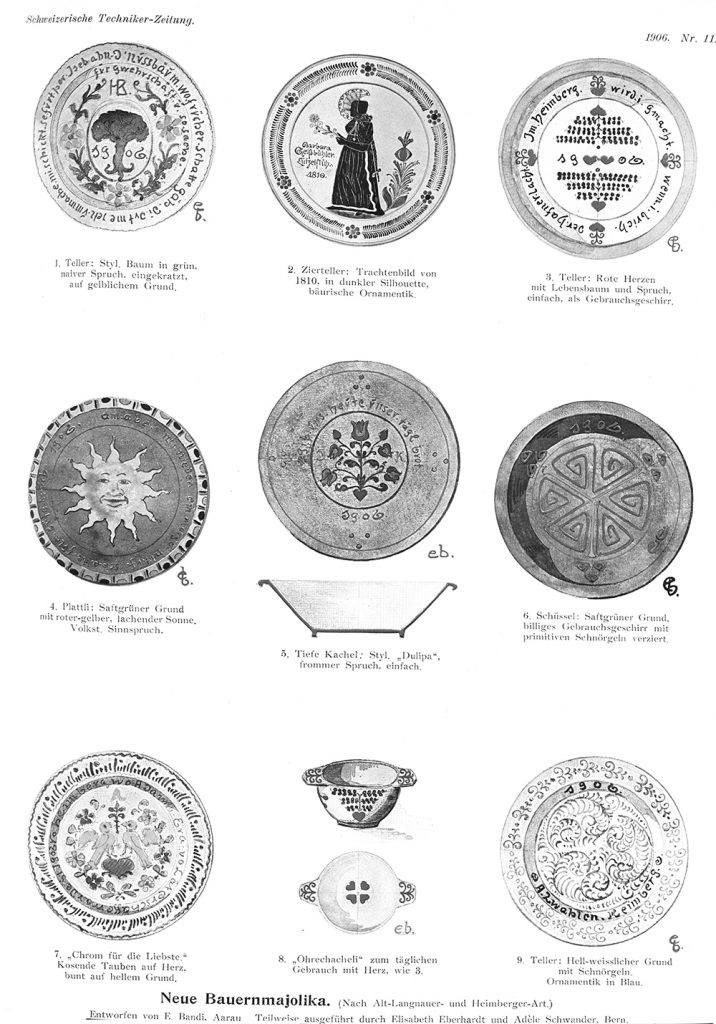
Schweizerische Technikerzeitung 1906.
It is therefore no surprise that some of her work was published under the title “new peasant majolica” in a supplement that came with the Schweizerische Techniker-Zeitung (a Swiss engineering newspaper) in 1906. The small number of early works by Elisabeth Eberhardt that have survived in museum collections also show that until about 1913/1915 she was still decorating vessels and vases with the regional slip-trailed and incised designs that were typical of the style taught at the Swiss School of Pottery (Messerli-Bolliger 1987, Catalogue 2-14). Her objects tended to be adorned with abstract floral and geometric designs.
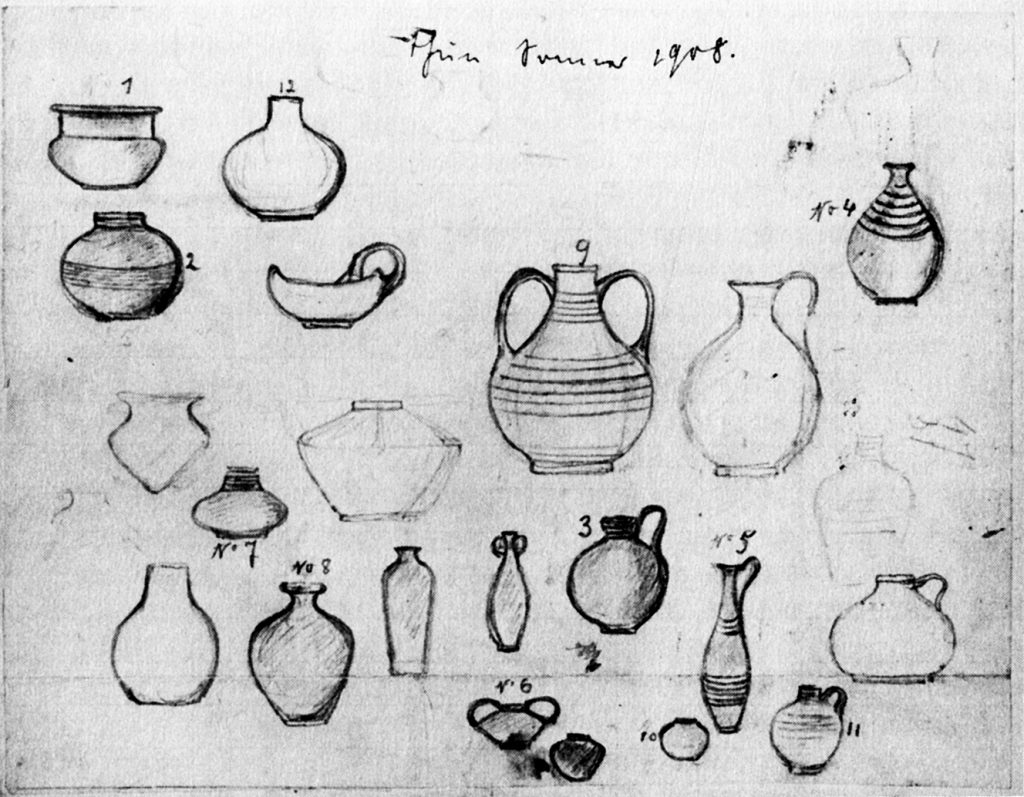
Sketches by Elisabeth Eberhardt, dated “Thun, summer 1908”. Photo © Museum Burghalde Lenzburg. www.museumburghalde.ch.
Having graduated from the School of Arts and Crafts she worked for another few years in the Heimberg-Steffisburg region (as attested to by pottery sketches dated 1908 and labelled “Thun”), before opening her own workshop (at an unknown location). However, the business failed, though it is not known exactly when, and she proceeded to create her ceramics, first at a workshop in Langnau (it is not known with whom, but it may have been with Adolf Gerber, who had set up a new workshop in 1911), and then – from 1914 at the latest – at the workshop of Karl Wespi on Entfelderstrasse road in Aarau, where she maintained her own work station. Her vessels were first made by Alfred Müller, and later, from 1923 until the workshop closed in 1928/1929, by Karl Müller.
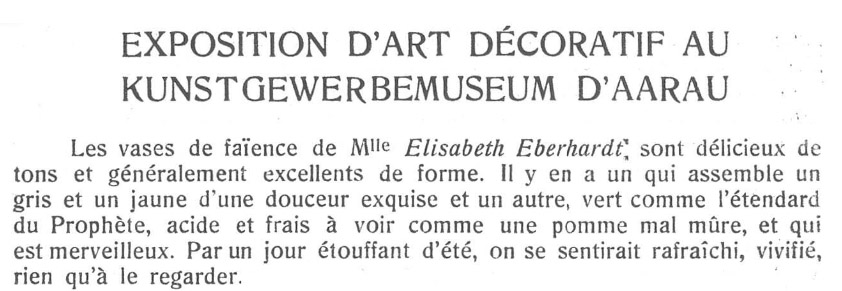
Wissen und Leben, Vol. 11, 1912-1913, 374
In 1912, Nora Gross published a very positive review of Elisabeth Eberhardt’s works that were on display at the Kunstgewerbemuseum (Museum of Decorative Arts) in Aarau.
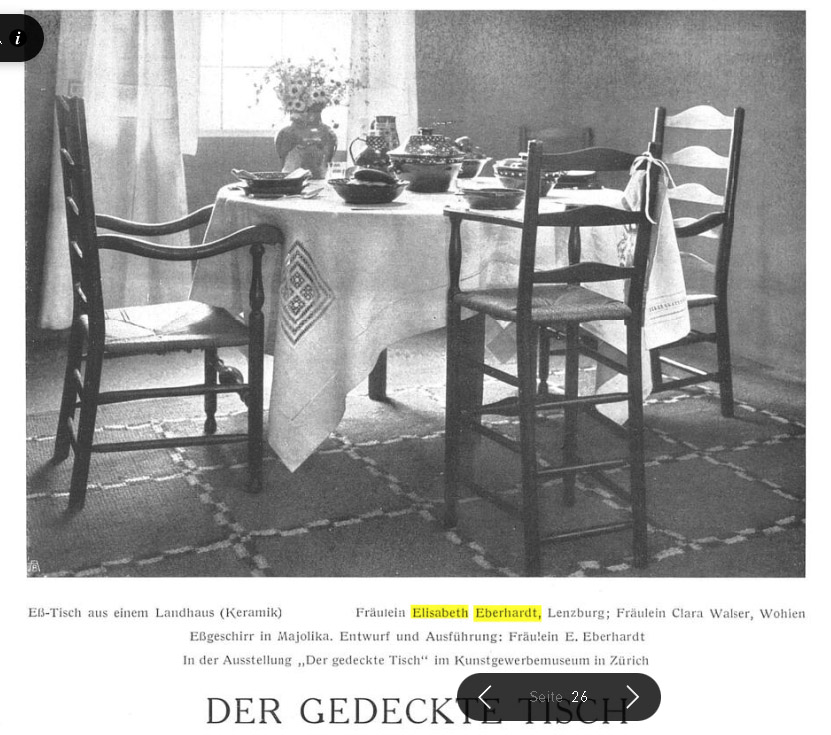
Das Werk : Architektur und Kunst = L’oeuvre : architecture et art, Volume 1 (1914), Issue 2, 26.
In 1913/1914, Eberhardt designed some of the pottery on show at an exhibition entitled “Der gedeckte Tisch” (The Table Is Set) at the Museum of Decorative Arts in Zurich.
In 1913 she exhibited some of her wares at the Salon d’automne in Paris, where her pottery was favourably reviewed: “… the peasant faience vessels by Ms. Eberhardt are delightful”. This suggests that the objects on display were still decorated with slip trailing.
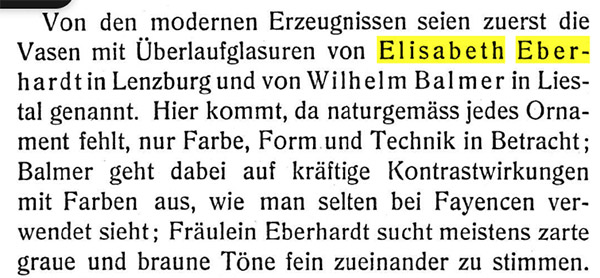
Heimkunst 1913, 8 (Text by Alfred Bauer).
From March to June 1913 her works could also be seen at a pottery exhibition presented by the Museum of Decorative Arts in Zurich. Alfred Bauer’s review in the NZZ newspaper, however, was rather dispassionate.
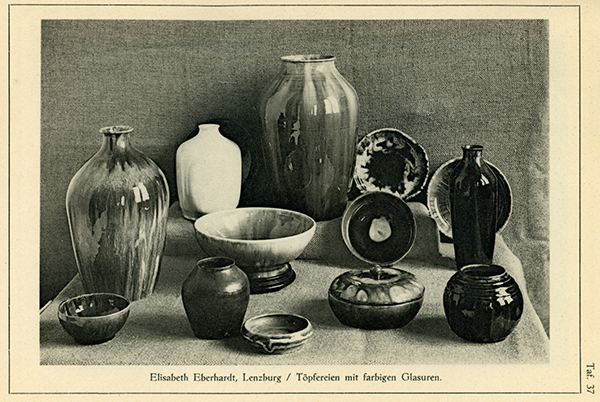
Some of Elisabeth Eberhardt’s designs in Franziska Anner, Die kunstgewerbliche Arbeit der Frau in der Schweiz, Chur 1916, Pl. 37.
Based on dated pieces that have survived from between 1913 and 1915, this seems to have been the period during which her design focus shifted to the shape of the vessel alone and from then on, her wares were decorated only with colourful and flowing glazes. As can be seen from the images above, this shift had already been completed by around 1916. In 1915, Elisabeth Eberhardt became one of the first women to join the Schweizerischer Werkbund, and some time before 1928 she also became a member of the Zurich section of the Gesellschaft Schweizerischer Malerinnen und Bildhauerinnen (Swiss Society of Female Painters and Sculptors) (GSMB), which in 1928 was renamed Gesellschaft Schweizer Malerinnen, Bildhauerinnen und Kunstgewerblerinnen, GSMBK (Swiss Society of Female Painters, Sculptors and Craftswomen).
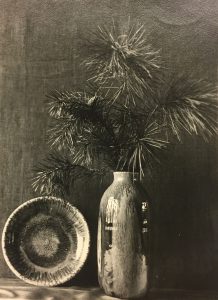
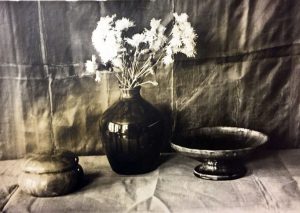
Contemporary photographs of her ceramic designs. Photo © Museum Burghalde Lenzburg. www.museumburghalde.ch.
In 1917 she took part in the XIII. Schweizerische Kunstausstellung (13th Exhibition of Swiss Art) in Zurich, in the Applied Arts section (Das Werk, Vol. 4, 1917, XIX).
In 1918, some of Eberhardt’s works were exhibited alongside those of J. Hermanns and Nora Gross at the exhibition of the Schweizerischer Werkbund in Zurich (Die Schweiz: schweizerische illustrierte Zeitschrift, Volume 22, 1918, 394).
In 1920 some of her works appeared in the journal “Das Werk, p. 240”.
In 1923 some of her works appeared in the journal “Das Werk” and very favourably reviewed by Emmy Fischer.
In 1925 she exhibited her designs at the Aargauer Industrie- und Gewerbeausstellung (Aargau Industry and Trade Exhibition) in Baden (where the Museum of Decorative Arts in Aarau (now Museen Aargau) acquired some of her objects for their collection).
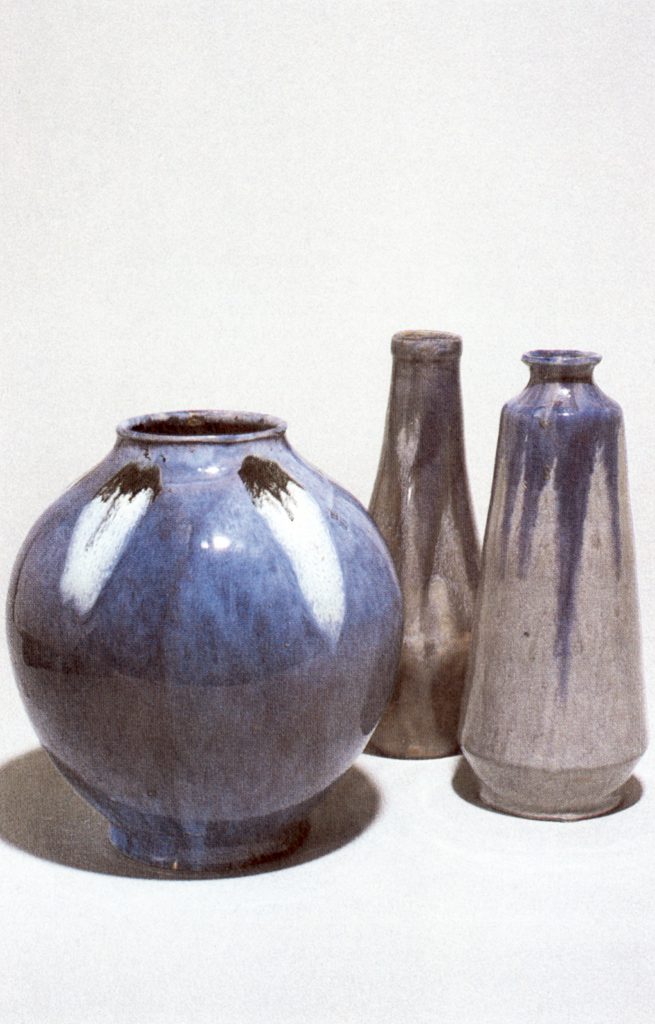
Pottery with colourful flowing glazes in the collection of the Museum Burghalde, Lenzburg. Photo by Hans Weber, Museum Bellerive Zurich and Gewerbemuseum (Industrial Museum) of Winterthur.
In 1928 Eberhart exhibited her pottery at “Saffa” (Swiss Exhibition of Women’s Work) in Bern. A review by Maria Weese and Doris Wild placed particular emphasis on her bowls and vases “… the main attraction of which are the elegant, finely graded glazes …” (Weese/Wild 1928, 28).
In 1928-1929 she had a work station at the workshop of Hans Brunner (1917-1982) in Lenzburg at Burghalde. Arguments over dripping glazes prompted her to move her work station to the workshop of her former throwers, Alfred and, more importantly, Karl Müller, who had a workshop in Unterkulm from 1928 to 1984. By 1931/1932, at the latest, however, she was back working at Brunner’s workshop in Lenzburg, with Walter Gebauer (1907-1998) acting as one of her throwers (Orelli-Messerli 2010). Between 1934 and 1938/39 she was back in Unterkulm in the Wynental valley, where she had a small space that allowed her to work undisturbed and keep testing and perfecting her glazes.
After a lengthy period of not exhibiting, we find Elisabeth Eberhardt’s works being displayed at another exhibition curated by the Swiss Society of Female Painters, Sculptors and Craftswomen in Bern in 1937. From 1938/1939 to 1951 she went back to work at Brunner’s workshop in Lenzburg, where she rented a long workbench for 5 francs a month.
In 1945, she turned 70 and was invited as guest of honour to the so-called Martini Dinner, which was traditionally held by the Lenzburg Library Association to celebrate the work of an artist. A small exhibition of some of her early and more recent works was also put on display.
Despite a small but devoted clientele, Elisabeth Eberhardt probably had a very modest lifestyle, which may partly have been subsidised by her inheritance.
The very distinct style of ceramics developed by Elisabeth Eberhardt between about 1913 and 1922 focused completely on form and glaze and was at odds with the floral style of Art Nouveau, Art Deco and traditional Swiss pottery popular at the time, placing her firmly among the avant-garde of Swiss pottery design. She would stay true to this type of pottery until she retired from designing ceramics at the age of 76. For an assessment of the artistic importance of Eberhardt’s work see Daniela Ball 2005.

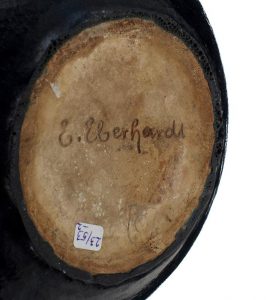
New acquisitions by the Museum Burghalde Lenzburg in 2018. Photo © Museum Burghalde Lenzburg. www.museumburghalde.ch. Photo of her mark courtesy of Auction House Zofingen, 59th auction 1980, lot 900.
Marks and signatures
Elisabeth Eberhardt signed her early works with the letters “EE..“.
She also used at least one impressed mark in the form of an escutcheon, one half consisting of the Swiss flag, the other of the Lenzburg coat of arms (Messerli Bolliger 1987, Catalogue 2).
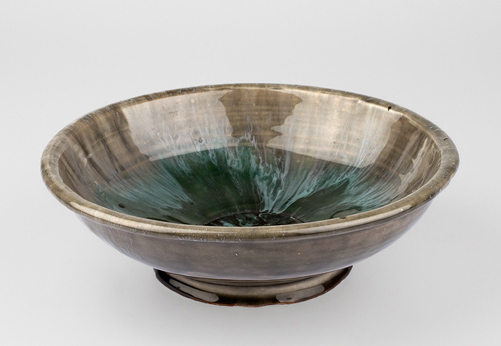

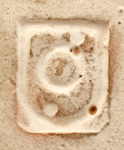
Other signatures included her full name “E. Eberhardt”, some combined with another slightly different impressed mark consisting of the Lenzburg coat of arms (for example EAA Inv. 0344).
Information about Elisabeth Eberhardt at “Antik und rar”.
Archival records and numerous ceramic objects by Elisabeth Eberhardt are kept in the collection of the Museum Burghalde in Lenzburg.
Pottery by Elisabeth Eberhardt in the collection of the Museum of Design in Zurich
Translation Sandy Haemmerle
References:
Attenhofer 1967
Ed. Attenhofer, Elisabeth Eberhardt, Keramikerin (1875-1966). Lenzburger Neujahrsblätter 1967.
Ball 2005
Daniela Ball, “Form ohne Ornament”? : Schweizer Keramik im Spiegel der Kulturdebatten der Zwischenkriegszeit. Kunst + Architektur in der Schweiz 56, 2005, 38-45.
Fischer 1923
Emmy Fischer, Zu den Töpfereien von Elisabeth Eberhardt, in: Das Werk: Architektur und Kunst = L’oeuvre: architecture et art 10, 1923.
Messerli-Bolliger 1987
Barbara E. Messerli-Bolliger, Die Lenzburger Keramikerin Elisabeth Eberhardt 1875-1966, in: Museum Burghalde Lenzburg (Hrsg.), Keramik der Region, Lenzburg 1987, 20-81.
Orelli-Messerli 2010
Barbara von Orelli-Messerli, Elisabeth Eberhardt (1875-1966) und Walter Gebauer (1907-1998): Eine keramische Begegnung als verpasste Chance?, in: Ralph Mennicken (Hrsg.), Keramische Begegnungen: Sachsen – Schlesien – Böhmen. Beiträge zum 42. Internationalen Symposium Keramikforschung des Arbeitskreises für Keramikforschung in Görlitz (D). Rareren 2010, 188-194.
Weese/Wild 1928
Maria Weese/Doris Wild, Die Schweizer Frau in Kunstgewerbe
und bildender Kunst. Schriften zur «SAFFA». Zürich und Leipzig 1928.

